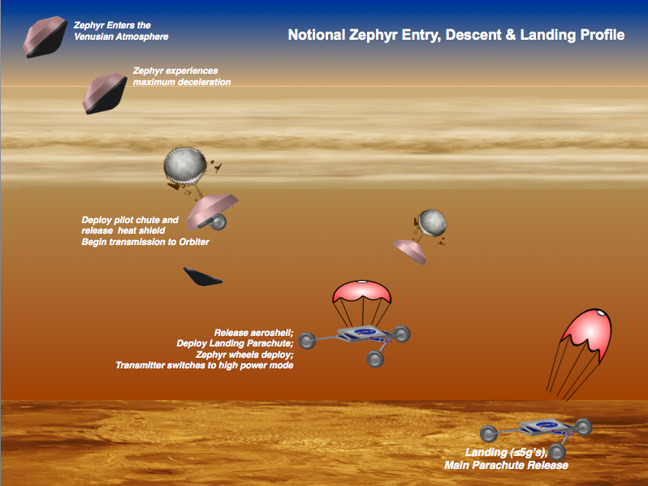A windsailing rover could use the high speeds and hot temperatures of Venus to a robotic explorer’s advantage, according to an idea funded by NASA’s Innovative Advanced Concepts program.
The rover would not only be able to move around Venus, but would also have electronics inside able to withstand the temperatures of 450 degrees Celsius (840 degrees Fahrenheit).
The rover, which is nicknamed Zephyr, would spend most of its time on Venus doing analysis on the ground. Whenever the science team wants to move some distance, however, it would deploy a sail that could bring it across the surface. One vision sees it sailing for about 15 minutes a day for about a month.

“A sail rover would be extraordinary for Venus. The sail has only two moving parts-just to set the sail and set the steering position-and that doesn’t require a lot of power. There’s no power required to actually drive,” stated Geoffrey Landis, who is with NASA’s Glenn Research Center.
“The fundamental elements of a rover for Venus are not beyond the bounds of physics,” Landis added. “We could survive the furnace of Venus if we can come up with an innovative concept for a rover that can move on extremely low power levels.”
Landis has had many ideas for exploring Venus, including using a solar powered airplane and colonizing the planet using floating cities.
You can read more details about the windsurfing rover here. If this gets to the mission phase, this would represent the first time that any robot landed on Venus since the Soviet Venera landers; the last attempt was in the 1980s.


Why would it be more important to have low power driving on Venus than on Mars? RPG:s launched from Earth are indestructable and one has even been reused in another satellite after crashing into the ocean. Being a meteor through the atmosphere and then being on the bottom of the ocean didn’t damage it. I think it could handle Venus too.
From the link: “Landis and his colleagues on the NIAC-funded study see their rover-replete with about 12 square meters of solar cell-laden sail-tooling across Venus for about a month, chalking up 15 minutes of sailing per day.” The dense atmosphere makes a solar cell driven rover having a small energy budget.
Why no RPG:s? Perhaps because of cost, low availability (RPG:s are dedicated for outer system missions) and perhaps to circumvent some political resistance (RPG:s are dedicated for outer system missions).
Good points.
Still I don’t see any explanation for how “sailing” would be a good idea, do submarines have sails in Earth’s oceans? And 15 minutes per day is very little. Especially for a short duration mission. Maybe some chemical fuel would be more suitable than RTG, if not Sterling engines with some source of coolness. I like innovative solutions to exploring Venus, but this seems weird.
Power could be provided by burning lithium within the hot CO2 atmosphere to churn a small sterling generator. Or just by sailing, would turn small generators in the wheels to charge high-temperature sodium sulfur batteries. Sailing can be a great way to move around. The entire ocean was explored by sail boats. It also works well for land. https://www.youtube.com/watch?v=oieUfXyYUBI
Actually, RTG’s are dependent on temperature differential for efficiency – the greater the temperature ratio between the hot and cold ends of the generator, the larger the voltage output. Obviously, this is not a problem in the coldness of outer space, but is a problem in the hot atmosphere of Venus.
IVAN3MAN gave a pretty good answer to the question about power source: a heat engine needs to reject waste heat in order to operate– power is generated from the difference in temperature between the hot and cold sides, and on Venus the “cold” side is going to be pretty hot. Another problem is that you have to keep the hot side insulated from the “cold” side, and on Venus, with its dense, high pressure atmosphere, this is difficult– the atmosphere is a pretty good conduction path to make everything the same temperature.
The wind-powered rover was a concept we came up with as an alternative to a radioisotope powered rover, because when we did a design study, the radioisotope-powered rover ended up being a bit heavy.
http://arc.aiaa.org/doi/pdf/10.2514/6.2011-7268
With that said, though, with some of the new approaches we’ve come up with from doing the landsailing rover design, where we worked pretty hard on minimizing mass and power, it may be worth looking at the isotope power system again.
Here’s a picture of the Zephyr rover here, if you’re interested.
Love your work. Thank you for coming here. Will the rover have a form of energy storage or will it run on direct solar energy?
Yes, a molten-salt battery (which operates at high temperature).
I really like this idea, because you can keep the electronics protected deep inside the rover. You wouldn’t need to expose wheel motors, etc. Landis has had many innovative ideas about exploring Venus, including using a Sterling Engine to keep the rover from overheating.
Wasn’t the inventor’s name Robert Stirling?
Indeed, but perhaps the idea to use the engine to power a cooling system was Landis’. Another idea is to use electronics that operate at a toasty 460° C and wouldn’t need cooling. I once read Honeybee robotics were working on a switched reluctance motor that can work on Venus as well.
Seems like a good idea for the most part, especially if there is enough power to cool electronics a little. With limited moving parts, machine could last a long time.
How do you avoid getting it snagged on a jagged rock though. With sailing it is random where the wind takes you when you take off. It would be like putting a blindfold on the Mars Curiosity rover and spinning her around a few times and then driving 100 meters. Eventually the rover would get stuck in a sand dune or wedged on a big rock.
Could mitigate this problem with camera to detect large objects which would allow the computer AI to determine whether it is safe to land and take down the sail. If area is strewn with obstructions, it would just stay aloft. Could also go to a real flat, uninteresting plain (limits science) on Venus and odds are you would be safe for a while (but doubt we have that detailed a map of Venus surface with just radar images).
It is possible to use thermocouples to generate electricity and use air conditioner inside to cool the electronics?
Regarding thermocouples, see my reply to Torbjörn.
Electronics made with the right materials don’t need any cooling.
I’d like to see this happen, I think that we have been spending to much time on Mars, and not enough on the Moon and exploring Venus. Granted, we have learned a lot from Mars, but we need to change the subject a little . . . we could possibly learn a lot more.
On another note, check out this on the BBC News Network! http://www.bbc.co.uk/news/science-environment-23779294I'm surprised they have nothing on this site regarding it.
Time to just send humans to mars. Send the rovers to all other places, but they’ve done all they can on mars.
You’d need to land on a flat plain…
“Most of Venus is remarkably flat,” – Landis
Don’t say that! She’s self conscious!
Shhh!!
Errr, doesn’t the stirling engine also needs a temperature difference?